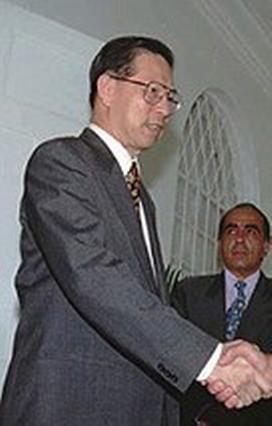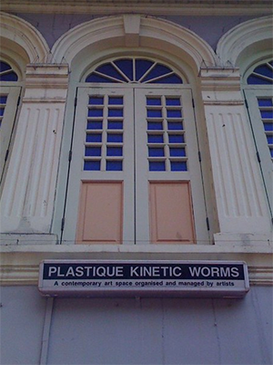
Ong Teng Cheong was a Singaporean statesman, architect and union leader who served as the fifth president of Singapore from 1993 to 1999.

LASALLE College of the Arts, simply known as LASALLE, is a publicly-funded post-secondary arts institution in Singapore, and a constituent college of the University of the Arts Singapore (UAS) from 2024.
The Institute of Contemporary Arts (ICA) Singapore is the curatorial division of LASALLE College of the Arts, dedicated to supporting innovative and emerging creative practices. Focusing on art and design from the present, it provides an active site for contemporary culture in Singapore. It comprises five galleries that span a total of 1,500 square metres, one of the largest spaces devoted to contemporary art in Singapore. It engages local and international audiences in critical viewing and discussion through a diverse programme of exhibitions, projects, publications and events.

The rights of lesbian, gay, bisexual, and transgender (LGBT) people in Singapore have evolved over the decades. Same-sex sexual activity is legal for both males and females; for men it was officially legalised in 2022 after being de facto decriminalised since 2007, and for women it was always legal. Prior to 2022, same-sex sexual activity between males was de jure illegal under the British colonial-era Section 377A of the Penal Code. The law had been de facto unenforced for decades. In February 2022, the Court of Appeal in the Supreme Court reaffirmed that 377A cannot be used to prosecute men for having sex with other men, and that it is "unenforceable in its entirety". Transgender rights in the country are also progressive in the region, which included Singapore being the first country in Asia to legalise sex reassignment surgery in 1973.

The National Arts Council (NAC) is a statutory board established on 15 October 1991 to oversee the development of arts in Singapore. It is under the purview of the Ministry of Culture, Community and Youth. The NAC provides grants, scholarships, awards and platforms for arts practitioners, as well as arts education and programmes for the general public.

The Singapore Biennale is a large-scale biennial contemporary art exhibition in Singapore, serving as the country’s major platform for international dialogue in contemporary art. It seeks to present and reflect the vigour of artistic practices in Singapore and Southeast Asia within a global context, fostering collaboration and engagement between artists, arts organisations, and the international arts community.

The Substation is Singapore's first independent contemporary arts centre. It was founded in 1990 by Kuo Pao Kun. The Substation is centrally located in the city's civic district and was the first building under the National Arts Council's "Arts Housing Scheme". It officially opened on 16 September 1990. The Substation is a non-profit organisation and registered Institution of Public Character in Singapore, which relies on financial and in-kind support from the general public, commercial organisations and government ministries to cover the costs of operating and developing arts & educational programmes.
Donna Ong is a Singaporean artist. She is known for her installation works, which often feature environments created with assemblages, found objects, and sculpture. Her practice draws upon notions of botany, landscaping, and representations of nature in both European and Chinese art.
Tang Da Wu is a Singaporean artist who works in a variety of media, including drawing, painting, sculpture, installation art and performance art. Educated at Birmingham Polytechnic and Goldsmiths' College, University of London, Tang gave his first solo exhibition, consisting of drawings and paintings, in 1970 at the Singapore Chinese Chamber of Commerce and Industry. He began engaging in performance art upon returning to Singapore in 1979 following his undergraduate studies.
Loo Zihan is a Singaporean actor, film director, artist and dancer. He was a part-time teacher at School of the Arts, Singapore, National Institute of Education (Singapore) and Nanyang Technological University.

The 5th Passage Artists Limited, commonly known as 5th Passage or 5th Passage Artists, was an artist-run initiative and contemporary art space in Singapore from 1991 to 1994. As a registered, artist-led non-profit organisation, it was one of the earliest of its kind for early-1990s Singapore, with its initial space located at Parkway Parade, a shopping centre in the east of the city. The "meteoric existence" of 5th Passage has been noted alongside other art collectives and alternative spaces existing in 1990s Singapore, such as The Artists Village, The Substation, Plastique Kinetic Worms, and Trimurti.

Juliana Yasin was a Singaporean contemporary artist and curator whose practice spanned painting, installation, video, and performance art. Her works examined notions of identity, subjectivity, and community practices. Pedagogy and research further complemented her artistic practice, with Juliana having taught fine art at Kolej Bandar Utama in Kuala Lumpur and worked as a Singapore-based researcher for the Asia Art Archive, Hong Kong.
Susie Lingham is a Singaporean contemporary artist, writer, curator, art theorist, and educator. Her practice often incorporates writing, sound, performance, and installation, synthesising interdisciplinary ideas related to the nature of the mind across different fields, from the humanities to the sciences.

Plastique Kinetic Worms (PKW) was a Singapore-based artist-run space and contemporary art collective, co-founded in 1998 by Singaporean artists Vincent Leow and Yvonne Lee. PKW was one of the few artist-run spaces in Singapore when it opened in the late 1990s, with the 1990 closure of the Ulu Sembawang site of Singapore's first artist colony, The Artists Village, and the disbanding of artist-run space and initiative, 5th Passage, after 1994. Originally organised around a collective of 10 artists, PKW's membership would vary, with around 15 to 20 members at various points of its active years.
Shubigi Rao is an Indian-born Singaporean contemporary artist and writer known for her long-term, multidisciplinary projects and installation works that often use books, etchings, drawings, video, and archives. Her interests include archaeology, libraries, neuroscience, histories and lies, literature and violence, and natural history. Rao has exhibited internationally, presenting work at the 59th Venice Biennale in 2022, 10th AsiaPacific Triennial in 2021, 10th Taipei Biennial in 2016, the 3rd Pune Biennale in 2017, the 2nd Singapore Biennale in 2008, as well as the 4th Kochi-Muziris Biennale in 2018.
Ming Wong is a Singaporean contemporary artist who lives and works in Berlin, known for his re-interpretations of iconic films and performances from world cinema in his video installations, often featuring "miscastings" of himself in roles of varied identities.
Lim Tzay Chuen is a Singaporean contemporary artist known for his conceptual works that involve designing or constructing subtle interventions within systems, leading viewers to re-evaluate their perceptions and assumptions of social, economic, cultural and political processes.

The visual art of Singapore, or Singaporean art, refers to all forms of visual art in or associated with Singapore throughout its history and towards the present-day. The history of Singaporean art includes the indigenous artistic traditions of the Malay Archipelago and the diverse visual practices of itinerant artists and migrants from China, the Indian subcontinent, and Europe.
Josef Ng Sing Chor is a Singaporean gallerist and former performance artist. He is known for his 1994 public performance Brother Cane, at the end of which he partially exposed his buttocks and snipped his pubic hair. Brother Cane was reportedly staged in protest of the imprisonment and caning of a group of homosexual men in Singapore the previous year; Ng called his hair-snipping a "symbolic gesture for an artistic purpose". He was handed a lifetime public performance ban by the National Arts Council and fined for violating the Penal Code. Ng later became a curator at various art galleries.









